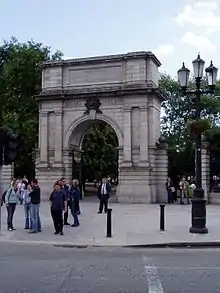Fusiliers' Arch
Fusiliers' Arch is a monument which forms part of the Grafton Street entrance to St Stephen's Green park, in Dublin, Ireland. Erected in 1907, it was dedicated to the officers, non-commissioned officers and enlisted men of the Royal Dublin Fusiliers who fought and died in the Second Boer War (1899–1902).


Construction
Funded by public subscription, the arch was designed by John Howard Pentland and built by Henry Laverty and Sons.[1] Thomas Drew consulted on the design and construction.[1]
The proportions of the structure are said to be modelled on the Arch of Titus in Rome.[2] It is approximately 8.5 m (28 ft) wide and 10 m (33 ft) high.[3][4][5] The internal dimensions of the arch are 5.6 m high and approximately 3.7 m wide (18 by 12 ft).[3][6]
The main structure of the arch is granite, with the inscriptions carried out in limestone and a bronze adornment on the front of the arch.
Dedication and reception
The arch was commissioned to commemorate the four battalions (two regular and two militia) of the Royal Dublin Fusiliers that served in the Second Boer war. It lists the principal battles and locations at which the fusiliers fought: Hart's Hill, Ladysmith, Talana, Colenso, Tugela Heights, and Laing's Nek.[6][7] The names of 222 dead are inscribed on the underside of the arch.[8][3]
The construction of the arch coincided with a time of political and social change in Ireland, and the colonial and imperial background to the dedication were anathema to a burgeoning nationalist movement – who labelled the structure "Traitor's Gate".[9][10][11] Though damaged in a cross-fire between the Irish Citizens Army and British troops during the 1916 Easter Rising,[8][12] the arch remains "one of the few colonialist monuments in Dublin not blown up" in Ireland's post-independence history.[9][11]
Notes and references
| Wikimedia Commons has media related to Fusilier's Arch, Dublin. |
- "Dictionary Of Irish Architects – Royal Fusiliers' Memorial Arch". Dia.ie. Retrieved 2012-08-02.
- "Fusiliers' Arch in Dublin, Ireland". Lonely Planet. Retrieved 2012-08-02.
- "Irishwarmemorials.ie – PDF with transcription and notes on inscriptions" (PDF). Irishwarmemorials.ie. Retrieved 30 November 2014.
- A plaque alongside the arch reads: "The Arch was constructed of Irish granite with the inscriptions carried out in limestone by Laverty & Sons from Belfast. The Arch stands 32 feet 6 inches in height and 27 feet and 3 inches in width"
- Reginald Brabazon (1924). Memories of the Twentieth Century. Murray.
The arch is 32 feet 6 inches in height, and the breadth 27 feet 3 inches, the proportions being exactly the same as those of the [Arch of Titus]
- Brück, Joanna; Tierney, Andrew (2009). "Landscapes of Desire. Parks, colonialism and identity in Victorian and Edwardian Ireland" (PDF). Report to the Heritage Council for Project No. 16785: 45. Archived from the original (PDF) on 17 October 2013.
- Cecil Francis Romer and Arthur Edward Mainwaring (1908). The Second Battalion Royal Dublin Fusiliers in the South African War. Project Gutenberg eBook. Retrieved 2012-08-03.
- "Irishwarmemorials.ie – Fusiliers' Arch entry". Irishwarmemorials.ie. Retrieved 30 November 2014.
- Donal P. McCracken (2003). Forgotten Protest: Ireland and the Anglo-Boer War. Ulster Historical Foundation. p. 148. ISBN 9781903688182. Retrieved 2 August 2012.
- Keith Jeffrey (2000-11-09). Ireland and the Great War. p. 116. ISBN 9780521773232.
- Murray, Christopher (2004). Seán O'Casey: Writer at Work : a Biography. Gill & Macmillan Ltd. p. 74. ISBN 978-0773528895.
- Casey, Christine (2006). Dublin: The City Within the Grand and Royal Canals and the Circular Road, with the Phoenix Park. Yale University Press. p. 533.
